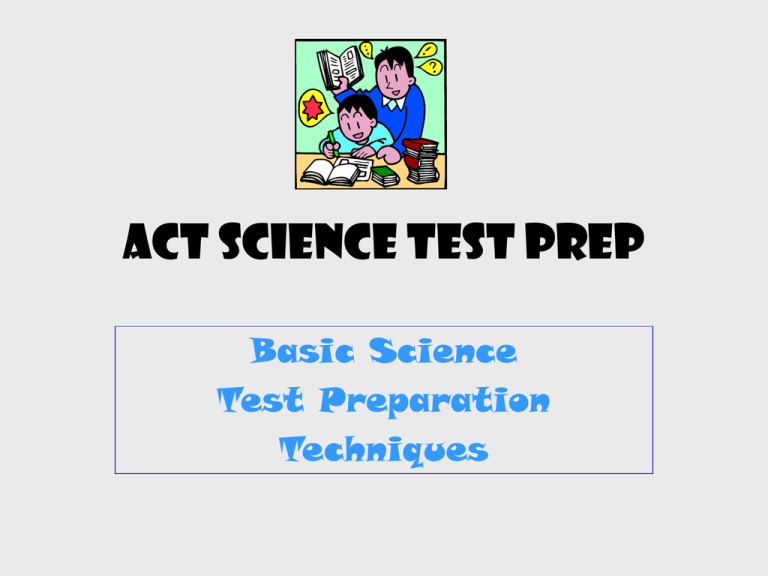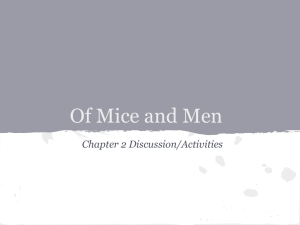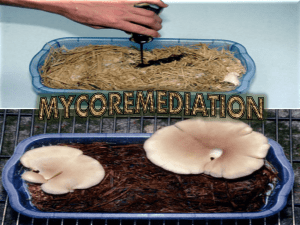act-science-test-prep
advertisement

ACT SCIENCE TEST PREP Basic Science Test Preparation Techniques * Important Reminder * Don’t worry about “not knowing enough science” to do well. The fact of the matter is, you do not need to be a science whiz to do well, though knowing science is a plus, the main information needed is in each passage. To do well, you will need to use some science reasoning and follow these test strategies. Reading Skills For Science Reasoning Kaplan’s Three-Step Method • Step 1: Skim and Scan the Passage • Step 2: Consider the Question • Step 3: Refer to the Passage 1: Skim and Scan the Passage Don’t get tied up in details. Sometimes it might be very technical and you’ll just get frustrated. Read the Introduction then scan the rest of the passage to see what information is being presented. Refer back to the passage when answering the questions. The main goal is to answer the question. You might not need to know all the information to do that. 2: Consider the Question Read and understand exactly what the question is asking. (This is almost as important as the answer…helps you to make an educated guess if you don’t know the answer.) Go back into the passage and get a sense of what the answer could be before looking at the choices. 3: Refer Back to the Passage When choosing the correct answer, make sure you look back at what it is asking for so your choice is expressing the correct units asked for. Also, make sure you don’t confuse “opposites”. The difference in a correct and incorrect answer may often be a “decrease” where an “increase” should be. Reading Tables and Graphs • Determine what is being represented. • Determine what the axes (columns and rows) represent. • Determine what the units of Measure are. • Look for trends in the Data. 90 80 70 60 50 East West North 40 30 20 10 0 1st Qtr 2nd Qtr 3rd Qtr 4th Qtr Determine what is being Represented and Determine what the Axes (x,y or Column, Row) Represents. • Most graphs and tables have titles…This one is “Air Temperature at Various Altitudes at Test Site #3”. • The X and Y axes are also usually labeled…X axes is “km above Sea Level” and the Y axes is “Air Temperature °C” Determine the units of Measure and Look for Trends in the Data Comparison of pollutants to populations of types of Trout Temperature is in degrees Celcius, pollutants are in parts per million and density is in # per 100 m³ of river. Trends show high lead in area 4 and high mercury in area 3. The trout can survive with lead in the water, but not mercury. WhaT To do When you’re running out of time ! • When you are running out of time, go right to the questions without reading the passage and do as many as you can… then use previous educated guess strategies to narrow choices down. – Watch out for absolutes – Answer easy ones first – Look for the answer that is concise and to the point – No guess means less so guess! Part Two – Scientific Method • In a passage, a general rule or law will be given to determine a specific fact or answer. example: the general law of gravity says that objects fall to earth at 9.8 m/sec². A falling object that takes 3 seconds to hit will be traveling roughly 30 m/sec. When it hits. 9.8m/sec³ x 3 sec. = 29.4 m/sec or 30 m/sec. Scientific Method continued • In some passages there will be facts to examine and a general conclusion to be given known as a “Hypothesis” or educated guess. • Once the facts are tested a specific conclusion based on the facts can be formed. Scientific Method Continued (Experimental phase) • After forming a hypothesis, one must prove it to be true or prove it to be false. In doing so, the experimental phase occurs. • A single variable (tested variable) is tested from sample to sample or group to group. • All other factors or variables must remain the same from sample to sample or group to group. (Control variables) • Data Analysis or interpreting what test information shows supports your hypothesis or disproves it. The Data Analysis interpretation is the most important part. Scientific Method Continued Analysis of the Data • 1. 2. 3. 3 plots, each with different soils, are planted with pine seedlings. Plot A gets treated soil and cultivated fungi. Plot B gets untreated soil and naturally growing fungi. Plot C gets treated soil without fungi. (All other factors were kept the same.) What factor is being varied or tested? Which Plot would be considered the control group? What do the results show? # of seedlings alive after 6 months Plot A – 107 Plot B – 34 Plot C - 0 Analysis of the Data Answers 1. The fungi in the soil or the lack of… 2. Plot B…it is untreated and has naturally growing fungi (natural state). 3. Results show that soil treated and cultivated with fungi promotes better seedling growth than natural and even better than soil lacking fungi. The End of Science ACT Test Prep Strategies And all of the Test Prep Advisory lessons….Best of luck on your tests.









